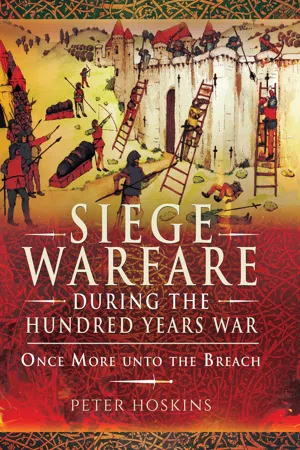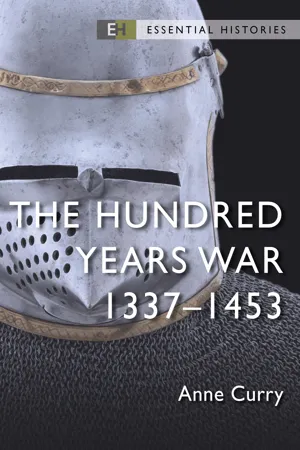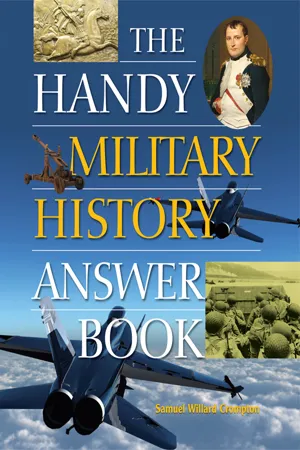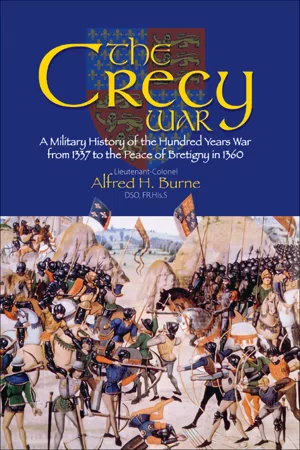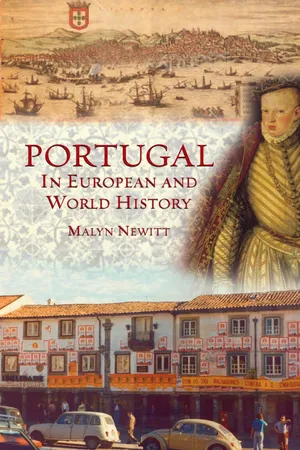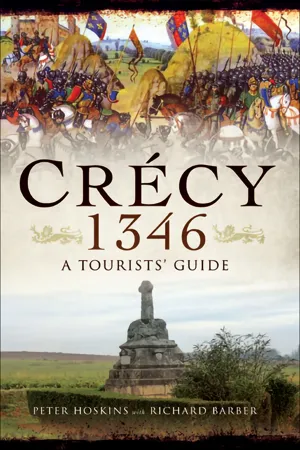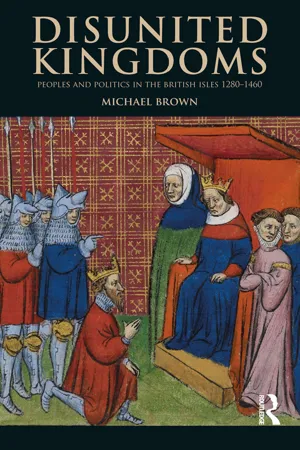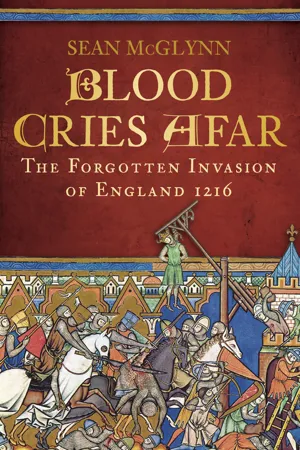History
Hundred Years War
The Hundred Years' War was a series of conflicts fought between England and France from 1337 to 1453. It was characterized by a complex mix of battles, truces, and shifting alliances. The war had a significant impact on the development of both countries and marked the end of medieval chivalry and the beginning of modern warfare.
Written by Perlego with AI-assistance
Related key terms
12 Key excerpts on "Hundred Years War"
- eBook - ePub
- Ephraim Emerton(Author)
- 2018(Publication Date)
- Endymion Press(Publisher)
THE HUNDRED YEARS’ WAR (1328 – 1453) ~ THE LONG CONFLICT BETWEEN FRANCE and England, to which historians have given the name of “The Hundred Years’ War,” interests us chiefly as an illustration on a great scale of the transition from the mediæval, feudal order of society to the modern, national idea of political organization. Its nearer causes were largely feudal, and its methods were still, to a great extent, those of the earlier period. Its remoter causes, however, and the motives that kept it alive are to be sought on both sides in a steadily growing sense of national unity and national honor. Under the feudal régime it may fairly be said that it mattered little to the landholding aristocracy whether it were under the sovereignty of one king or another. The thing it really cared about was whether its privileges were such as it had a right to expect, and whether these privileges were likely to be fully and honorably maintained. So long as this was the case the barons found their profit and their glory in standing by their king in those undertakings which had a certain national character. But if their rights were tampered with, or if another sovereign offered equal guaranties of privilege, they easily took advantage of the flexible feudal arrangements to shift their allegiance. While this is true of both the countries engaged in this desperate struggle, there is evident by the close of the thirteenth century a very marked difference between them. English feudalism had always differed from that of France in its relation to the overlord. The impulse given to the royal power by William the Conqueror had never been quite lost. The rights of the crown had been steadily enforced, and what might have seemed a great disadvantage, namely, the absence of a large and compact domaine which might become the nucleus of a monarchical state, had really proved an element of strength - eBook - ePub
Siege Warfare during the Hundred Years War
Once More unto the Breach
- Peter Hoskins(Author)
- 2018(Publication Date)
- Pen and Sword Military(Publisher)
Chapter 1 The Hundred Years War Sieges, like the great battles of the Hundred Years War, mean little out of the context of the broader history of the war, particularly as the strategies adopted by both sides evolved throughout the war. It was only in the nineteenth century that historians coined the term ‘the Hundred Years War’ to cover the conflict between the English and French kings between 1337 and 1453. The name is somewhat misleading since it gives the impression of a period of continual warfare, whereas there were several distinct phases of war interspersed by periods of truce and peace, and the strategies employed varied between these phases. The English strategy in the reign of Edward III from the outbreak of war in 1337 until his death in 1377 was largely one of mobile warfare through mounted raids called chevauchées. There were numerous sieges, most notably those of Tournai in 1340 and Calais in 1346–1347, but overall the objectives of the strategy were to take the war deep into enemy territory and to bring the French to battle if the circumstances were right. This strategy has been described by the historian Clifford J. Rogers as being focused on people rather than places, with a key objective to bring the French to battle in favourable circumstances for the English. Under Henry V, and until the end of the war, the emphasis of English strategy changed. Bringing the French to battle was still an objective, but taking and holding towns to establish English rule took primacy - eBook - ePub
The Hundred Years War
1337–1453
- Anne Curry(Author)
- 2023(Publication Date)
- Osprey Publishing(Publisher)
THE FIGHTING The Hundred Years War: a narrative The first phase: 1337–60Given the length and complexity of the war, it is possible here to concentrate only on direct Anglo-French conflict. It must be remembered, however, that fighting also took place in Scotland, the Low Countries and Spain, and that troops from many areas were involved. In this respect, as in the diplomatic context, it is fair to see the Hundred Years War as the first pan-European war.It began, like the wars of 1294 and 1324, in Aquitaine. In July 1337 the French army, which launched its attack through the Agenais, and the Count of Foix’s force, which entered from the south, pursued campaigns of harassment and small-scale devastation. This is a timely reminder that the French were often as keen on the chevauchée -style raid as the English. This strategy was preferred when troops were few and money inadequate for long-term operations and occupation, and when war was intended to be waged on more than one front.In 1338, the French launched further attacks through the Agenais and Saintonge. Although these were repulsed by the seneschal and his Gascon supporters, the lack of reinforcements from England meant that by the spring of 1339 the French were able to make serious inroads and were now establishing garrisons along the Dordogne and Garonne. Bordeaux was threatened with encirclement after the key outposts of Bourg and Blaye fell with the assistance of a French fleet in April 1339.A pavillon d’or of Philip VI issued in 1339 which portrays the crowned king on a throne under a canopy. Philip’s sceptre is topped by the fleur-de-lys. (Photo by Heritage Art/Heritage Images via Getty Images)Philip intended to keep an army of 12,000 on the Garonne only until June 1339, at which point he planned to concentrate all his forces along the Somme in anticipation of the invasion of Edward and his allies. But Edward’s delayed arrival led to French pressure on Gascony continuing. Siege was now laid to Bordeaux itself, but the attackers’ supplies were low and they departed after only a week. Ingham was able to carry out some raids towards Toulouse in October, perhaps even intended as a co-ordinated move with Edward’s invasion in the north. - eBook - ePub
Landscapes of Trauma
The Psychology of the Battlefield
- Nigel Hunt(Author)
- 2019(Publication Date)
- Routledge(Publisher)
This chapter briefly examines the late medieval and early modern period; in particular the period which became known as the Hundred Years War between the English and the French. The evidence for any psychological impact of this war is very limited, virtually non-existent. Languages change significantly over time. The English language has evolved from the languages spoken by the Saxons, Angles and others who came to the British Isles from the fifth to the sixth centuries. Along the way it picked up a lot of words and syntax from the Scandinavian languages and from French. For the purposes of the present book, at the time of the Hundred Years War the main language of many people in England was a form of Chaucerian Middle English, with many (not necessarily mutually intelligible) variants around the country. By this time English was also the dominant language of the ruling classes, after several centuries of the rulers speaking French. There are two key sources in this chapter, one English but writing a long time after the war and writing for entertainment – Shakespeare. The second is French, an older form of French, written by Froissart in his detailed account of the Hundred Years War.The Hundred Years WarThe Hundred Years War between England and France was not a single conflict, nor did it last 100 years. It lasted 116 years and was several conflicts, ending with England being ejected from most of what we now know as France, apart from Calais. We know very little about the ordinary soldiers of these wars, though the wars were chronicled in detail at the time of the wars by Froissart (1978) in Contemporary Chronicles of the Hundred Years War . Froissart details the key people and events of most of this period, including the killing of soldiers and civilians in battle and elsewhere, but there are few details of the impact these events had on anyone, other than minor details about the more senior personages. Contemporary accounts provide limited evidence for the psychological impact of war on soldiers or civilians.Froissart focused on the importance of honour in battle and on how war can appear like a tournament: “Many gallant deeds of arms were performed, many knights and squires on each side were unhorsed and pushed back into the saddle.” (Whittington, 2016, p. 27) In more practical terms, Froissart noted the growing importance of the English archer, first at Crecy in 1346, then at Poitiers in 1356, where he notes: “the English archers were an inestimable advantage to their comrades, and struck terror into the hearts of the French, for the rain of arrows was so continuous and so thick that the French did not know where to turn to avoid them, with the result that the English kept gaining ground,” and then again at Agincourt in 1415. The French had major difficulties in dealing with this weapon. “Most of the knights and all of their horses were driven back among the vanguard for fear of the English archers.” (Whittington, 2016, p. 28) The sheer terror of seeing hundreds of arrows flying through the air at the same time, with the rush of air, must have been for the French similar to that experienced by the Germans facing the Russian rocket launcher in World War II, the Katyusha, which the Germans labelled Stalin’s organ because the array of rocket launchers looked like a pipe organ and the howling sound was terrifying to the soldiers. Noise has always been used as a weapon to terrify the enemy, preferably attached to a lethal weapon, whether English arrows, Russian rocket launchers, or the German Stuka with its siren wailing as it divebombed the enemy. - eBook - ePub
- Samuel Willard Crompton(Author)
- 2015(Publication Date)
- Visible Ink Press(Publisher)
Chroniques, c. 1410.There must have been more to this war than dynastic struggle, or else people would never have stayed with the conflict. Is that correct?Yes. The dynastic conflict between the English and French was the initial reason for the Hundred Years’ War, but to sustain the bad feeling and desire for blood, there had to be more. By about 1350, England and France were locked in a struggle that was economic, social, and dynastic.How severe did the Hundred Years’ War become?The major armies were bad enough, but the mercenary forces that attended them were even worse. On both sides, the monarchs employed thousands of mercenary soldiers who preyed on the civilians. France suffered much the worst of this, as so much of the fighting was on its side of the English Channel.By the 1370s, both England and France were on the verge of bankruptcy, and social disturbances began in earnest. In France, a rebellion known as the Jaquerie nearly toppled King Charles V; in England, the major disturbance came in the form of Wat Tyler’s Revolt. In both instances, the established order eventually prevailed, albeit at an enormous cost in money, arms, and men.Did anyone see that the time had come to end this fratricidal conflict?Various Popes mentioned the fact, and numerous churchmen waxed indignant about how the two nations should combine to fight the Ottoman Turks. England and France were locked in a life-or-death struggle, however, and things only became worse when Burgundy exerted all of its power on behalf of the former.The dukes of Burgundy had long been uneasy subjects of the French crown. Many of their subjects identified with Germany, or the Holy Roman Empire. By the 1420s, Burgundy was firmly in the English camp, with disastrous results for France. The single worst day of the Hundred Years’ War had already come and gone, however. - eBook - ePub
The Crecy War
A Military History of the Hundred Years War from 1337 to the Peace of Bretigny in 1360
- Alfred H. Burne(Author)
- 2016(Publication Date)
- Frontline Books(Publisher)
CHAPTER I PRELIMINARIEST HE seeds of the Hundred Years War were sown as far back as A.D . 1152 when Henry Plantagenet, count of Anjou, married Eleanor, the divorced wife of Louis VII of France and heiress to the duchy of Aquitaine. Two years later Henry succeeded to the throne of England and Normandy and thus found himself in possession of the whole of western France from the English Channel to the Pyrenees. For all this vast area – a good half of France – he was the nominal vassal of the king of France and thus the unnatural position was established of a king in his own right being also the vassal of another king. What made it worse was that the vassal was often more powerful than his suzerain. It is therefore not surprising that for the next 300 years every king of England was at some time or another at war with the king of France.The situation was aggravated in 1259 by the complicated Treaty of Paris which made various adjustments and new enactments and reaffirmed the vassal status of the English dominions in France. No king of France enjoyed the sight of a rival monarch in occupation of a large portion of the land of France, and no king of England could stomach the thought of having to do homage to another monarch whom he regarded as his equal. It made matters worse when the two were blood relations. The Treaty of Paris produced so much confusion and conflict that some historians have dubbed the ensuing 80 years “The First Hundred Years War”.Edward III was only 14 years of age when, in 1327, he succeeded to the throne of his luckless father, Edward II. Although he had a French mother, the notorious Isabella, he was born and brought up in an atmosphere and tradition of enmity with France; his ears were filled with stories of French insolence and bad faith and he smarted with humiliation at having to travel to France and do homage to his rival. The seeds of war had been so well sown that it would have been little less than a miracle if the peace had been maintained throughout his reign. In fact we need look no further than the duchy of Aquitaine to explain the outbreak of a conflict that was to last off and on for over 100 years. - eBook - ePub
- Malyn Newitt(Author)
- 2009(Publication Date)
- Reaktion Books(Publisher)
The long and relatively prosperous reign of Dom Dinis contrasts with the fifty years which followed, years which saw the Black Death devastate the country and the kingdom drawn into the ever widening European conflict of the Hundred Years War. As with other medieval monarchies, political instability frequently arose from disputed successions which split society along the social fissures of class interest and noble faction. Portugal had experienced civil wars in the thirteenth century and in the fourteenth century the irregular sexual partnerships of its kings were to exacerbate class tensions and in the end endanger the very survival of the country’s independence. It was the threat to this independence and the struggle to control this small kingdom during the 1380s that made Portugal the arena where the outcome of the wider conflict north of the Pyrenees would be decided. For a few years the ambitions of the European military elite, and the attentions of the chroniclers who recorded their activities, became focused on events in Portugal.The Hundred Years War
The Hundred Years War, which began with the disputed succession following the death of Charles IV of France in 1328, was not at first a new phenomenon. In the twelfth century dynastic marriages had resulted in the creation of the great Angevin kingdom which stretched from the borders of Scotland to the Pyrenees. Although its rulers, Henry II , Richard and John, found great difficulty in controlling this vast domain, and still more in mobilizing its resources, it nevertheless over shadowed the kingdom of France to which its Norman and Aquitainian lands were nominally subject. The kingdoms of England and France had few effective institutions and depended on feudal loyalty to control the military elites, who constantly sought to boost their fortunes through the spoils of war. The conquest of Normandy by the French early in the thirteenth century had hugely increased the power of the French monarchy and had removed Angevin influence from the area of the Low Countries but the kings of England, who were expanding their political power into Ireland, Wales and Scotland, still ruled extensive lands in the south of France bordering the Pyrenees.When Edward III - eBook - ePub
The English Experience in France c.1450-1558
War, Diplomacy and Cultural Exchange
- David Grummitt(Author)
- 2017(Publication Date)
- Routledge(Publisher)
Only with the excessive taxation of those years and Wolsey's attempt to levy the Amicable Grant was the general support for war with France called into question. 27 By the 1540s government propagandists like Richard Morison were whipping up support for renewed war with the old enemy using the new, nationalistic language of the Henrician supremacy. 28 Even in 1557-8, when England was involved in war largely to meet the demands of Mary I's husband, Philip II of Spain, the political classes on the whole greeted war enthusiastically. Despite some grumbling from ordinary people reported by the Venetian ambassador, it was seen on the whole as an opportunity to unite a divided nation and win honour and advancement. 29 Diplomacy The English were engaged in open war with the French for less than fifteen years between 1450 and 1558. The end of the Hundred Years War marked a period of extended truces and, after the treaty of Etaples in 1492, an age of more formal peace treaties delineating intermittent periods of war. The conduct of diplomacy, as well as war and trade, shaped the experience of the English in France. To what extent though did English diplomatic relations with France represent a coherent policy in the century or so after 1450? It used to be thought that the Tudors, and Henry VII in particular, eschewed wars of conquest and sought to build a 'modern' foreign policy vis-a-vis France - eBook - ePub
Crécy 1346
A Tourists' Guide
- Peter Hoskins, Richard Barber(Authors)
- 2016(Publication Date)
- Pen & Sword Military(Publisher)
EDWARD III AND THE Hundred Years WarEdward III’s great victory at Crécy-en-Ponthieu in 1346 sent shock waves throughout Europe. There had been earlier English victories since the start of the war with France, now known as the Hundred Years War, nine years earlier. However, this victory marked the start of a period when the English seemed invincible. Ten years later there was a further great victory at Poitiers. The subsequent Treaty of Brétigny in 1360 ceded large areas of France to the English crown and seemed set to deliver Edward III a long-term peace with France. Edward III’s achievements, including his victory at Crécy, have earned him a reputation as one of the greatest of English kings. However, Crécy is often viewed in isolation from the broader history of the Hundred Years War. His success can be better appreciated by looking at it within the context of the war as a whole.Causes of the Hundred Years WarThere were two underlying causes of the war which started in 1337: the homage claimed by the French kings from the kings of England for their lands in France, and the English claim to the throne of France. They remained central to the conflict between England and France throughout the war.The anomaly whereby English kings owed homage to kings of France can be traced back to William the Conqueror, who was both King William I of England and Duke of Normandy. The situation was exacerbated when Henry II came to the throne in 1154. He had acquired extensive lands in south-western France through his marriage to Eleanor of Aquitaine. Thus, he and subsequent English kings ruled the Duchy of Aquitaine centred on the city of Bordeaux. The status of Aquitaine was a persistent cause of dispute between the kings of England and France over the years, with kings of France demanding homage from the English kings who proclaimed their right to full sovereignty as Duke of Aquitaine. In the years immediately preceding the Hundred Years War there were protracted diplomatic wrangles between Edward III and Philip VI. Matters came to a head in 1337 with a dispute over the extradition from England of a French exile, Robert of Artois, a one-time adviser to Philip. Edward refused to return Robert to France, and Philip declared Edward’s Duchy of Aquitaine forfeit. With war coming, Edward revoked his homage for Aquitaine. - eBook - ePub
War: What is it good for?
The role of conflict in civilisation, from primates to robots
- Ian Morris(Author)
- 2014(Publication Date)
- Profile Books(Publisher)
Prime ministers expect to be pilloried for everything they say, but there is probably no way to try to evaluate the legacy of Europe’s Five Hundred Years’ War without being accused of political bias. Accepting that, I will steel myself for the worst and come right to the point: the Five Hundred Years’ War was the most productive—in the sense I have used that word in this book—war the world had so far seen, creating the biggest, safest, and most prosperous society (or world-system) yet. In 1415, the globe had been fragmented, with each continent dominated by a cluster of regional powers. By 1914, this ancient mosaic was gone, replaced by just three or four powers with truly global reach (France, Germany, the United States, and, of course, the United Kingdom), tightly linked in a system dominated by Britain. Europe had (almost) conquered the world.The marriage of invisible hand and invisible fist made the modern world-system very different from any premodern empire, but the Five Hundred Years’ War that created it had nevertheless followed a broadly familiar pattern. First came a conquest phase, driving up rates of violent death; next, in many cases, came an era of rebellion, with more great bloodlettings; and finally came an age of peace and prosperity as violence declined and economies were reconstructed on a larger scale.The timing of the phases depended on where you lived. The wave of conquest broke on South and Central America in the sixteenth century, on North America in the seventeenth through nineteenth centuries, on India in the eighteenth and nineteenth centuries, on China in the mid-nineteenth century, and on Africa in the late nineteenth century, with the major rebellions generally coming hard on the heels of the end of the conquests.The effects varied as much as the timing. In the Americas, invaders visited unspeakable horrors on the natives (and, it should be said, the natives repaid them in kind when they could), but, as we saw earlier in this chapter, the great killer was disease. If, as I think we should, we count the victims of pestilence and famine among the war dead, the figures are shocking. Between 1500 and 1650, the Native population of the New World fell by half. Those historians who call the conquest an “American holocaust” have a point. - eBook - ePub
Disunited Kingdoms
Peoples and Politics in the British Isles 1280-1460
- Michael Brown(Author)
- 2014(Publication Date)
- Routledge(Publisher)
David II , 62–5.26. MacDonald, Border Bloodshed; Boardman, The Early Stewart Kings: Robert II and Robert III ; A. Grant, ‘The Otterburn War from the Scottish Point of View’, in Tuck and Goodman (eds), War and Border Societies , 30–64.27. Macdougall, An Antidote to the English: The Auld Alliance , 25–51; Penman, David II , 67–72; MacDonald, Border Bloodshed , 75–116; Sumption, Trial by Fire , 152–3, 171–4.28. Barrow, Robert Bruce , 183; Penman, David II , 185–93, 229–32; Boardman, Early Stewart Kings , 109–10; MacDonald, Border Bloodshed , 25–6; Brown, Wars of Scotland , 282–90.29. Brown, Black Douglases , 150–2, 210–14; MacDonald, Border Bloodshed , 97; Campbell, ‘England, Scotland and the Hundred Years War’, 155–83.30. Ormrod, ‘Edward III and his Family’, 409–15; Palmer, ‘England, France, the Papacy and the Flemish Succession’; Goodman, John of Gaunt , 48–51, 111–43.31. Le Patourel, ‘The King and the Princes’; M. Jones, ‘The Crown and the Provinces in the Fourteenth Century’, in D. Potter (ed.), France in the Later Middle Ages (Oxford, 2002), 61–89.32. D. Nicholas, Medieval Flanders (London, 1992), 150–230; J.F. Veerbruggen, The Battle of the Golden Spurs: Courtrai, 11 July 1302 (Woodbridge, 2002), 1–28; F. Funck-Brentano, Philippe le Bel et Flandre (Paris, 1897).33. P. Gaillou and M. Jones, The Bretons (Oxford, 1991), 199–206; M. Jones, ‘The Capetians and Brittany’, Historical Research , 63 (1990), 1–16.34. M. Jones, Ducal Brittany, 1364–1399 (Oxford, 1970), 20–2, 45–6, 93–7; P. Gaillou and M. Jones, The Bretons (Oxford, 1991), 217–29, 234–7; J.B. Henneman, Olivier de Glisson and Political Society in France under Charles V and Charles VI (Philadelphia, 1996), 1–54; Nicholas, Medieval Flanders - eBook - ePub
Blood Cries Afar
The Forgotten Invasion of England 1216
- Sean McGlynn(Author)
- 2013(Publication Date)
- The History Press(Publisher)
Invasions of England remained an active option of French policy exercised into the eighteenth century, and threatened (as we have seen in chapter one) into the nineteenth. English dreams of recovery in France began fading after the Hundred Years War, despite the long drawn out and optimistic claims of royal titles over the centuries; invasions by Edward IV and Henry VIII did little to keep these dreams alive. In reality, such campaigns and assertions of sovereignty were used more to apply political and diplomatic pressure in pursuance of much more modest objectives. The loss of Calais in 1558 during Queen Mary’s reign finally put paid to the hereditary hopes of the English crown (but not the claims). Long before then all hopes of re-establishing the Angevin Empire had been abandoned: the empire technically came to an end in May, 1259, by the Treaty of Paris. 151 This treaty, concluded by John’s son and successor, Henry III, and Philip Augustus’ grandson, Louis IX, saw the English renounce all claims to Normandy, Poitou, Touraine, Maine and Anjou. In a poor return for this, the English King was acknowledged as Duke of Aquitaine, for which he paid homage to the King of France. Although the treaty did mark the formal demise of the Angevin Empire, it did little to alleviate Angevin-Capetian or Anglo-French rivalry, the antagonism persisting for centuries to come. 152 As argued in chapter one, Richard the Lionheart’s continental campaigns were undertaken as much for the good of England’s security as for his own Angevin patrimony, and the security concerns for both sides remained to the fore long after 1259. War and politics may be tribal, religious, dynastic, national, civil or inter-communal, but they remain war and politics, they remain power struggles. In 1204, the struggle that led ultimately to the Treaty of Paris might have led instead to Anglo-Imperial dominance of France or to another Norman conquest of England
Index pages curate the most relevant extracts from our library of academic textbooks. They’ve been created using an in-house natural language model (NLM), each adding context and meaning to key research topics.

